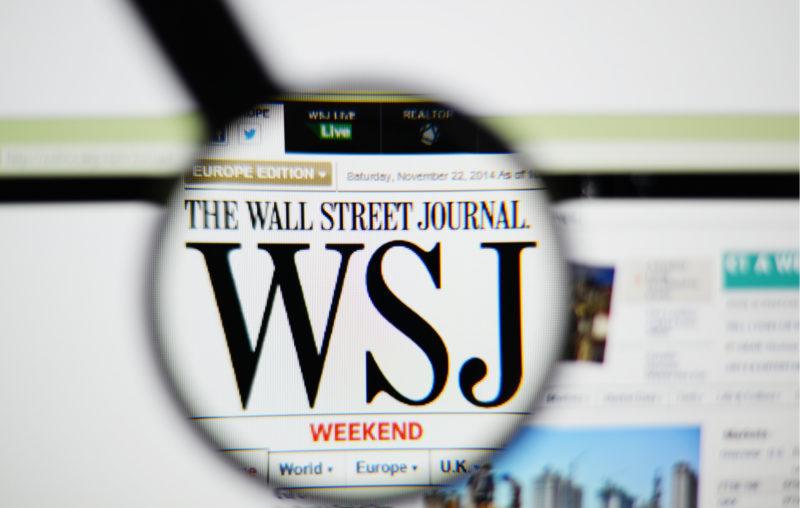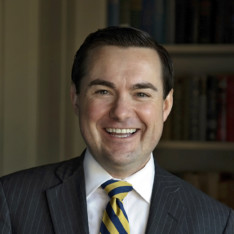A Tribute to the Wall Street Journal’s Editorial Page

From the beginning of this pandemic, what is called the mainstream media has been almost universally on the side of panic and lockdowns. From trumpeting inaccurate forecasts to using every opportunity to push fear and shame dissent, media performance has been poor. They even went so far as to politicize this disease, treating it as yet another opportunity to fuel division and score one for their team.
My own sense is that people who have been glued to their televisions throughout this have a tremendously distorted perspective. Those who are looking for alternative points of view have fared much better. But it is not always easy. Censorship by the tech giants is becoming increasingly ferocious. Case in point is an interview with Dr. Knut Wittkowski, a leading bio-statistician and epidemiologist, which was taken down for disagreeing with the line. Fortunately, the video is still found at AIER.
Amidst the confusion, the Wall Street Journal’s editorial page has been a voice of clarity, even from the outset of the lockdowns. Founded in 1889, it has one of the largest circulations of any paper in the world, with 2.8 million in print and 1.8 million in digital. Their influence has been legendary through the years, standing up for free enterprise. In this case, I only wish the paper had been much more influential.
Early advocates of lockdowns commonly argue that either one was on the side of caring or on the side of corporate profits. Two months later, we now know that the lockdown disproportionately hurts low income people. The highest paid 20 percent (those earning more than $32.50 per hour) have seen an increase in unemployment of less than 10 percent, whereas more than one in three of the bottom 20 percent earners (those earning less than $13.50 per hour) have lost their job. Those numbers are from nearly three weeks ago and surely things are worse now. I have long been predicting how it would harm lower income people first and unfortunately those predictions are increasingly true.
Yet through all of this the Wall Street Journal has been prescient and a leading source of good sense the entire time. Barely a few days into the shutdown, on March 19, 2020, the page wrote the following.
Financial markets paused their slide Thursday, but no one should think this rolling economic calamity is over. If this government-ordered shutdown continues for much more than another week or two, the human cost of job losses and bankruptcies will exceed what most Americans imagine. This won’t be popular to read in some quarters, but federal and state officials need to start adjusting their anti-virus strategy now to avoid an economic recession that will dwarf the harm from 2008-2009.
The vast social-distancing project of the last 10 days or so has been necessary and has done much good. Warnings about large gatherings of more than 10 people and limiting access to nursing homes will save lives. The public has received a crucial education in hygiene and disease prevention, and even young people may get the message. With any luck, this behavior change will reduce the coronavirus spread enough that our hospitals won’t be overwhelmed with patients. Anthony Fauci, Scott Gottlieb and other disease experts are buying crucial time for government and private industry to marshal resources against the virus.
***
Yet the costs of this national shutdown are growing by the hour, and we don’t mean federal spending. We mean a tsunami of economic destruction that will cause tens of millions to lose their jobs as commerce and production simply cease. Many large companies can withstand a few weeks without revenue but that isn’t true of millions of small and mid-sized firms.
Even cash-rich businesses operate on a thin margin and can bleed through reserves in a month. First they will lay off employees and then out of necessity they will shut down. Another month like this week and the layoffs will be measured in millions of people.
The deadweight loss in production will be profound and take years to rebuild. In a normal recession the U.S. loses about 5% of national output over the course of a year or so. In this case we may lose that much, or twice as much, in a month.
Our friend Ed Hyman, the Wall Street economist, on Thursday adjusted his estimate for the second quarter to an annual rate loss in GDP of minus-20%. Treasury Secretary Steven Mnuchin’s assertion on Fox Business Thursday that the economy will power through all this is happy talk if this continues for much longer.
If GDP seems abstract, consider the human cost. Think about the entrepreneur who has invested his life in his Memphis ribs joint only to see his customers vanish in a week. Or the retail chain of 30 stores that employs hundreds but sees no sales and must shut its doors.
Or the recent graduate with $20,000 in student-loan debt—taken on with the encouragement of politicians—who finds herself laid off from her first job. Perhaps she can return home and live with her parents, but what if they’re laid off too? How do you measure the human cost of these crushed dreams, lives upended, or mental-health damage that result from the orders of federal and state governments?
Some in the media who don’t understand American business say that China managed a comparable shock to its economy and is now beginning to emerge on the other side. Why can’t the U.S. do it too? This ignores that the Chinese state owns an enormous stake in that economy and chose to absorb the losses. In the U.S. those losses will be borne by private owners and workers who rely on a functioning private economy. They have no state balance sheet to fall back on.
The politicians in Washington are telling Americans, as they always do, that they are riding to the rescue by writing checks to individuals and offering loans to business. But there is no amount of money that can make up for losses of the magnitude we are facing if this extends for several more weeks. After the first $1 trillion this month, will we have to spend another $1 trillion in April, and another in June?
By the time Treasury’s small-business lending program runs through the bureaucratic hoops—complete with ordering owners that they can’t lay off anyone as a price for getting the loan—millions of businesses will be bankrupt and tens of millions will be jobless.
***
Perhaps we will be lucky, and the human and capitalist genius for innovation will produce a vaccine faster than expected—or at least treatments that reduce Covid-19 symptoms. But barring that, our leaders and our society will very soon need to shift their virus-fighting strategy to something that is sustainable.
Dr. Fauci has explained this severe lockdown policy as lasting 14 days in its initial term. The national guidance would then be reconsidered depending on the spread of the disease. That should be the moment, if not sooner, to offer new guidance on what might be called phase two of the coronavirus pandemic campaign.
That will surely include strict measures to isolate and protect the most vulnerable—our elderly and those with underlying medical problems. This should not become a debate over how many lives to sacrifice against how many lost jobs we can tolerate. Substantial social distancing and other measures will have to continue for some time in some form, depending on how our knowledge of the virus and its effects evolves.
But no society can safeguard public health for long at the cost of its overall economic health. Even America’s resources to fight a viral plague aren’t limitless—and they will become more limited by the day as individuals lose jobs, businesses close, and American prosperity gives way to poverty. America urgently needs a pandemic strategy that is more economically and socially sustainable than the current national lockdown.
Now we must fast forward nearly months, and amidst incredible intimidation, near-monopolistic opinionating, and rampant censorship, the Journal published the following blistering editorial: The Economic Lockdown Catastrophe.
When we wrote on March 19 about “Rethinking the Coronavirus Shutdown,” the reaction in elite media quarters was horror and denunciation. Well, after Friday’s horrific jobs report, how do you like the shutdown now? The people who said we have to sacrifice the economy to crush the virus have succeeded in the former even as the virus will be with us for many more months or longer.
Unemployment in April soared to 14.7%—the highest rate since the government started keeping records in 1948—while employers shed 20.5 million more jobs after losing 870,000 in March. The labor-market bleeding is even worse than those numbers suggest since 6.4 million workers left the workforce.
Labor participation had been trending upward the past two years as faster job growth drew millions of low-income Americans from the sidelines. But the participation rate has now fallen 3.2 percentage points to 60.2% since a recent peak in February, the lowest since 1973 before large numbers of women started working.
***
Much of the media continue to treat the economic destruction as a sideshow and present a false choice between saving lives and jobs. But this is the fastest jobs collapse in modern history. The Great Depression drove millions of Americans into poverty and caused many suicides, and there’s a substantial risk this could happen again.
Mental-health crisis hotlines are reporting spikes in calls. According to Express Scripts, anti-anxiety prescriptions increased by a third between mid-February and mid-March. Many in despair will probably turn to alcohol or narcotics. CVS executives warned this week that delayed care could lead to a surge of non-coronavirus related health problems. They include cancers undiagnosed and illnesses left untreated.
Hospitals have also had to cancel elective procedures, which is how they make most of their money. Stanford Health Care is cutting pay by 20% for its 14,000 workers. The California Medical Association reported that revenues at private practices have declined by two-thirds since March 1, and half have furloughed or laid off staff.
Congress has appropriated $175 billion to shore up hospitals, but this won’t help small physician practices much. Many health-care providers warn they may not survive if their privately insured patients lose jobs and sign up for Medicaid, which doesn’t cover their costs.
Businesses are also going under. This week J.Crew and Neiman Marcus filed for bankruptcy, and many more will follow. Some over-leveraged companies may have failed anyway, but many small businesses that were healthy before the government-induced coma are closing permanently. Consider Griswold’s Tavern in Newport, Rhode Island, or an iconic Italian bistro Biba in Sacramento, both of which had been around since the 1980s.
ADP this week reported that small businesses shed 11 million jobs in April. According to the Labor report, 8.2 million leisure and hospitality jobs—about half of the industry—have been eliminated in two months. Many Democrats seem to think this is no big deal since many laid-off workers will be able to collect enhanced unemployment benefits that pay more than their wages. But what happens in a few months if their employers no longer exist?
***
The crowd that demands the economy remain locked-down until there’s a vaccine, miracle therapy or daily testing of everyone in the country seem to think the government can replace the private economy. That’s a fantasy, and they are betraying the very low- and middle-income workers they claim to represent. Average wages in April rose sharply because so many low-income workers were laid off.
While they blame President Trump for the economic pain, Democratic leaders want to keep the economy sedated far longer to ease pressure on the health-care system. California Gov. Gavin Newsom this week relaxed his state stay-at-home order, but most Bay Area counties have extended their lockdowns through May 31 even though they have relatively few deaths and thousands of unused hospital beds.
Even in New York City, 26% of hospital beds and 21% of intensive care units are now free. After a seven-week lockdown, thousands of New Yorkers are still testing positive and hundreds are hospitalized each day. “Government has done everything it could. Society has done everything it could,” Gov. Andrew Cuomo said.
He’s right, but then why not reopen? Americans need to work to make a living, and they want to work. But the longer the shutdowns go on, the more furloughs become long-lasting unemployment. Many Americans who quit the labor force during the 2008-2009 recession took years to return, and some never did. Who knows how many won’t this time?
***
It is important to stress that the strict lockdowns were a government policy choice. But the damage is done, and our focus isn’t on recriminations. The issue is what to do now, and the public is wise enough to know that public health can’t be sustained without a healthy economy. Americans can see the destruction all around them. They know the virus will be with us for a long time unless there’s a vaccine, so we have to learn to live with it and have a functioning economy.
No politician wants to admit it, but we are moving to a de facto policy that gives people and businesses the leeway to open and make their own risk calculations. Most Americans are smart enough to know they need to take precautions and social distance, and businesses have no incentive to endanger their employees. Meat packers are learning that lesson the hard way.
The tradeoff isn’t between lives and livelihoods. The policy goal has to be to protect both as much as possible. Deploy more personal protective equipment, greatly increase testing, build surge capability to handle flare-ups, and isolate society’s most vulnerable to keep hospitals from getting overwhelmed. But for heaven’s sake reopen the economy so we don’t consign millions to years of poverty.
Hats off to the editors of the Wall Street Journal. After all this is ended and we are left with the wreckage, and huge questions about why the U.S. followed the path of lockdown rather than allowing the medical system and individuals primary responsibility for disease mitigation, the Journal will be seen as a heroic voice in the midst of disaster.












